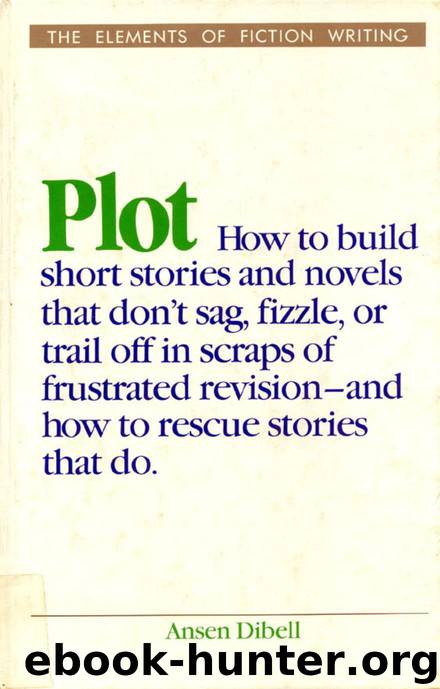Ansen Dibell - Plot by Elements of Fiction Writing

Author:Elements of Fiction Writing
Language: eng
Format: mobi
Published: 0101-01-01T00:00:00+00:00
CHAPTER 8
PATTERNS, MIRRORS,
AND ECHOES
I'VE SAID THAT EVERY STORY makes promises to its readers,
promises the writer has to take care to keep. Mostly, those prom-
ises are unspoken ones. And some are made indirectly, through
pattern.
Just by writing, you're choosing what happens and what
doesn't, what's possible in your little world and what isn't. What your characters are concerned about becomes, automatically,
your story's concern as well. The kinds of people whom you se-
lect as your characters—their attitudes and capacities, the kind
of relationships they get into—all are going to add up to some-
thing.
Detail on detail, incident on incident, character on charac-
ter, the pattern begins to form: the implicit rules and realities of your fictional world. A reader may not notice the patterns at
first, at least not consciously; but if they're carefully orchestrated and controlled, they're what hold your story together, give it
both diversity and unity, and make it specially your own.
With enough accumulated detail, a shape starts to form.
Any two dots define a line; any three, a triangle. Even yarrow
stalks, tea leaves, and random Tarot cards fall into patterns from which people attempt to read meanings. It's part of the way the
human mind works: finding faces in clouds, seeking shape, seek-
ing meaning. So how could your story, which certainly has more
intrinsic significance than a few soggy tea leaves, hope to escape?
94
Patterns, Mirrors, and Echoes 95
Patterns are going to happen. The question is whether
you're going to guide them into symmetry and significance, or
whether they're going to spring up, sprout branches in eleven-
teen contrary directions, and then slump like weeds.
The problem, at its simplest, is recognizing your tentative,
partial patterns as they accumulate and strengthening them,
making them coherent, getting other things out of their way to
let them stand straight and tall. The next and harder stage is go-
ing beyond basic weeding to cultivating: creating patterns delib-
erately, to gain for your writing the immense but subtle power of
recurrence, the second level of meaning that can only be spoken
in echoes.
MANY HAPPY RETURNS
In school, you were probably taught, as I was, to avoid simple
verbal repetition—using "however" or "interesting" too often in a single paragraph.
That's not what I'm talking about.
The kinds of repetition that work in fiction, that make bur-
ied but not-quite-hidden connections that can hold a story to-
gether, aren't a matter of single words. They're part of a writer's larger vocabulary: image, incident, situation, character. Narrative structure. Plot in the largest sense—not just what happens,
but precisely how the incidents are presented and the patterns they make.
Return with Us to the Thrilling Days of a Galaxy
Far, Far Away
I'll ask you now to flip back to Chapter 5, near the end, where I
did a bit of commentary on the structure of The Empire Strikes Back. Reread that section, then meet me back here.
OK? You're back?
There, I was talking about parallel plots, and how they can
be held together with echoing incidents. Now, the focus is on the
incidents themselves.
9 6 P L O T
A threat of freezing, in the beginning of that story, mirrors
a threat of freezing at the end. A cave in one of the parallel plot lines is mirrored by a cave in the other.
Download
This site does not store any files on its server. We only index and link to content provided by other sites. Please contact the content providers to delete copyright contents if any and email us, we'll remove relevant links or contents immediately.
Asking the Right Questions: A Guide to Critical Thinking by M. Neil Browne & Stuart M. Keeley(5353)
Autoboyography by Christina Lauren(5085)
Dialogue by Robert McKee(4156)
Eat That Frog! by Brian Tracy(4147)
Sticky Fingers by Joe Hagan(3907)
Journeys Out of the Body by Robert Monroe(3458)
Annapurna by Maurice Herzog(3291)
Full Circle by Michael Palin(3265)
Elements of Style 2017 by Richard De A'Morelli(3235)
Schaum's Quick Guide to Writing Great Short Stories by Margaret Lucke(3182)
The Art of Dramatic Writing: Its Basis in the Creative Interpretation of Human Motives by Egri Lajos(2856)
The Diviners by Libba Bray(2798)
Why I Write by George Orwell(2771)
The Mental Game of Writing: How to Overcome Obstacles, Stay Creative and Productive, and Free Your Mind for Success by James Scott Bell(2763)
In Patagonia by Bruce Chatwin(2752)
Atlas Obscura by Joshua Foer(2703)
The Fight by Norman Mailer(2697)
Venice by Jan Morris(2424)
The Elements of Style by William Strunk and E. B. White(2375)
